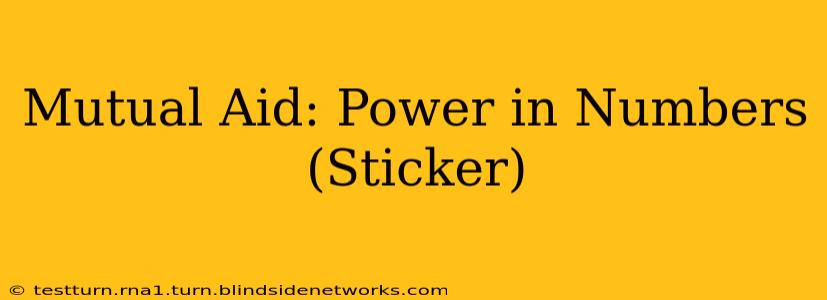Mutual Aid: Power in Numbers (Sticker) - A Deeper Dive into Collective Action
The simple phrase "Mutual Aid: Power in Numbers" emblazoned on a sticker might seem straightforward, but it speaks volumes about a powerful philosophy and a vital social movement. This isn't just a catchy slogan; it's a call to action, a reflection of human resilience, and a testament to the strength found in collective effort. Let's unravel the meaning behind this potent message and explore its significance in today's world.
What is Mutual Aid?
Mutual aid, at its core, is a philosophy and practice of reciprocal support within a community. It's about people helping each other directly, without the need for intermediaries or bureaucratic systems. Think of it as a network of support based on solidarity, empathy, and shared responsibility. Instead of relying solely on institutions, individuals collaborate to address common needs and challenges, fostering a sense of community and collective well-being.
This isn't a new concept. Historically, mutual aid has been a cornerstone of human survival, appearing in countless societies throughout history. From village cooperatives to workers' unions, people have always recognized the power of banding together to overcome adversity. The sticker acts as a visual reminder of this age-old practice, urging us to rediscover its relevance in contemporary society.
Why is Mutual Aid Important Today?
In an increasingly individualistic and often isolating world, the message of mutual aid feels particularly resonant. We face numerous challenges—economic inequality, environmental crises, social injustices—that can feel overwhelming when tackled alone. Mutual aid offers a powerful antidote to these feelings of helplessness. By collaborating, we can amplify our individual strengths, pool our resources, and create impactful change. This is the "power in numbers" aspect – our collective action can be far more effective than individual efforts.
How Can I Participate in Mutual Aid?
Participating in mutual aid doesn't require grand gestures or significant resources. Even small acts of kindness and support can contribute to a powerful collective effect. Here are a few ways to get involved:
- Join or create a local mutual aid network: Many communities have established networks focused on specific needs (food security, housing assistance, etc.). Seek out these groups or start your own.
- Offer your skills and talents: Do you have a skill that can benefit others? Offer to help with gardening, tutoring, repairs, or whatever you're good at.
- Contribute resources: Even small donations of food, clothing, or money can make a significant difference.
- Spread the word: Share information about mutual aid initiatives and encourage others to participate.
What are Some Examples of Mutual Aid?
The beauty of mutual aid lies in its adaptability. It manifests in countless ways depending on the needs of a community. Here are a few examples:
- Community gardens: These provide fresh produce and foster a sense of shared purpose.
- Free stores/clothing swaps: These redistribute unwanted items, reducing waste and supporting those in need.
- Food pantries and meal sharing initiatives: These address food insecurity and ensure everyone has access to nutritious food.
- Neighborhood watch programs: These enhance safety and security through collaborative community action.
Is Mutual Aid the Same as Charity?
While both mutual aid and charity involve providing support, there's a crucial difference. Charity often implies a hierarchical relationship, with a donor giving to a recipient. Mutual aid, on the other hand, emphasizes reciprocity and shared responsibility. It fosters horizontal relationships, where everyone is both a giver and a receiver, building a stronger, more resilient community.
What are the Benefits of Mutual Aid?
The benefits extend far beyond material assistance. Participating in mutual aid fosters:
- Stronger communities: It creates bonds of solidarity and trust.
- Improved well-being: It provides emotional and social support.
- Empowerment: It allows individuals to take control of their lives and circumstances.
- Social change: By addressing systemic inequalities, it contributes to broader social justice.
The "Mutual Aid: Power in Numbers" sticker is more than just an image; it's a powerful symbol of collective action, resilience, and human connection. It's a reminder that even small acts of support, when combined, can create transformative change and build a more just and equitable world. The power is truly in our numbers.

